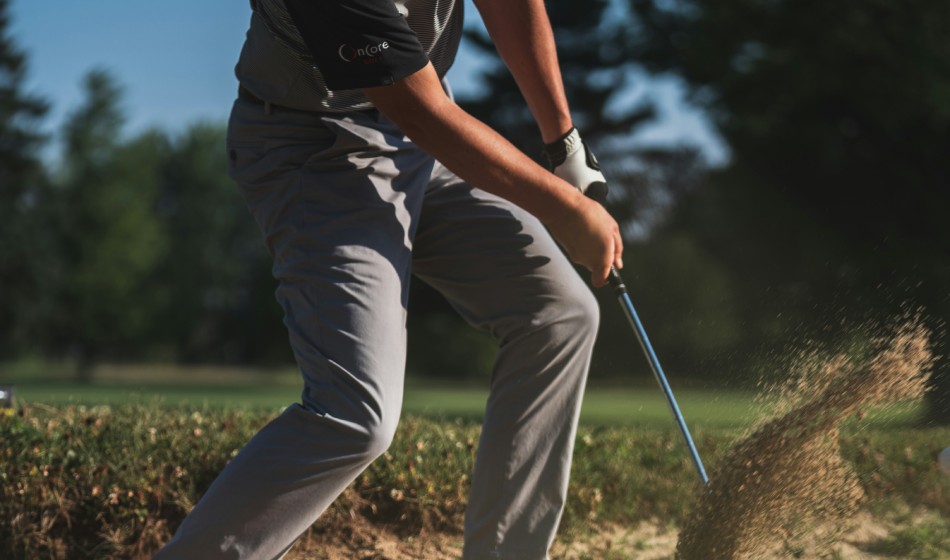
Grip in Golf: Learn to hold the Golf club
17 de February de 2024
The grip is the only point of contact between you and the golf club, and it has a tremendous impact on every shot. A correct grip can mean the difference between an accurate shot and an erratic one. Therefore, learning to hold the golf club properly is fundamental for any golfer, whether novice or experienced.
We will show you how to perfect your grip technique to improve consistency and accuracy in your game. Whether you’re looking to correct bad habits or start on the right foot, we will provide you with practical tips that will help you achieve a firm and reliable grip.
From the interlocking grip to the Vardon, through personalized tips for your style of play, we will dive into the keys so you can master the art of golf grip. So, adjust your gloves and get ready to transform your swings with our expert guide.
What is the grip in golf
The grip in golf is much more than the way we hold the club. It is the only direct point of contact between the player and the club, making its correct execution crucial for the accuracy and power of the shot. A good grip can make the difference between a deviated shot and one that successfully reaches the target.
There are different types of grip that golfers can adopt, each with its peculiarities and benefits. Some of the most common are the Vardon grip, interlocking, and the baseball. The choice of one over the other will depend on the comfort and personal technique of each player.
Moreover, the grip is not just the technique, but also the material that covers the handle of the club. This must offer a good grip and withstand varied weather conditions, from humidity to extreme heat. The quality of the material can influence the control and sensation of the shot.
The grip in golf is a fundamental element that connects the player with the club. Practicing and perfecting our grip is essential to improve our game. Remember, a correct grip is the start for more accurate and controlled shots.
Types of golf club grips
The grip is that essential link between you and your golf club. Mastering it is key to an effective swing. Let’s look at the most common types of grips:
- Ten-Finger Grip: Also known as “baseball grip”, each finger is placed on the grip of the club. Ideal for players with smaller hands or limited strength.
- Interlock or Interlocking Grip: The right-hand pinkie and the left-hand index finger interlock (for right-handed players). It offers a perfect balance between strength and control.
- Overlap or Overlapping Grip: The right-hand pinkie is placed on the space between the index and middle finger of the left hand. It is preferred by players with larger hands.
- Vardon Grip: A variant of the overlapping grip, popularized by Harry Vardon. It brings more consistency to the swing and is very popular among professionals.
Choosing the correct type of grip is a personal decision and should feel comfortable and natural. Experiment and find the one that best suits your style of play.
Adjusting posture and hand alignment
The grip or club hold is fundamental in golf; it is your only connection with the club and determines the accuracy of your shot. Therefore, it is vital to ensure that your posture and the alignment of your hands are correct. Here are some practical tips to perfect your technique.
First, place your hands on the club handle so that they form a ‘V’ with your index fingers and thumbs. These ‘Vs’ should point approximately towards your right shoulder (if you are right-handed) or left (if you are left-handed). This ensures that your hands work together during the swing.
The pressure you apply is also key. Imagine you are holding a tube of toothpaste without a cap; you want to prevent the contents from coming out, but without crushing it. So, maintain a firm, yet relaxed grip, to allow a fluid swing and avoid unnecessary tension.
Additionally, the position of your hands must be symmetrical. Make sure that the leading hand (the left for right-handed players, the right for left-handed players) does not dominate the grip. A good technique is to align the knuckles so you can see two or three of them on the leading hand when looking down.
Lastly, keep in mind that the alignment of the hands may vary slightly depending on the type of shot you want to perform. However, consistency in your grip will help you develop a precise and reliable repetition in your shots. Practice these adjustments and you will notice how your game improves.
Exercises to strengthen grip and accuracy
Understanding the importance of the grip or hold in golf is vital. A firm and precise grip can completely change your game. Therefore, here we present some exercises that will improve your technique.
- Coin exercise: Place a coin on the top of your hand right where the grip would rest. Practice smooth swings without dropping the coin. This improves stability and the pressure applied to the club.
- Swings with intermediate grip: Use a lighter grip when performing swings. This forces you to maintain a delicate balance, thus training the precision and sensitivity in your hands.
- Use of grip trainers: Grip trainers are tools designed to teach you the correct hold. Use them regularly to develop muscle memory.
With these exercises, you will not only strengthen your grip but also increase the accuracy of your shots. Constant practice is key to seeing significant improvements in your game.
Mistakes to avoid when gripping a golf club
Gripping the golf club correctly is essential for an effective swing. However, it’s easy to fall into common mistakes. Let’s identify the most frequent ones so you can avoid them and improve your game.
Gripping too tightly: Tension is the enemy of a fluid swing. A grip that is too tight can lead to erratic shots. Imagine holding a bird: firm so it doesn’t escape, gentle so as not to harm it.
Gripping too loosely: On the other hand, a grip that is too loose can cause the club to move in your hands, affecting precision and control. Find that middle ground for consistent contact with the ball.
Incorrect finger placement: Fingers should wrap around the handle in a way that allows both control and comfort. Avoid positioning them too far or too close to the top of the grip.
Hand misalignment: Your hands must work together as a unit. Ensure that the left hand (for right-handed players) leads and that the right (for right-handed players) supports, maintaining a harmonious alignment.
Ignoring grip size: A grip that doesn’t fit your hand can sabotage your game. If your hands are larger or smaller than average, consider changing the grip size to improve the hold.
Avoiding these mistakes will help you maintain an optimal grip and execute a swing with greater confidence and precision. Take your time to practice and feel the right grip, your game will thank you.
Remember that the basis of an effective swing starts with a good grip. The way you hold the golf club is the direct link between your body and the flight of the ball. So, take the necessary time to practice and perfect your grip.
Whether you prefer the interlock, overlap, or the ten-finger grip, consistency is key. Make sure that every time you take the club, your grip is firm but relaxed. Excessive tension can sabotage your technique and the fluidity of your swing.
And remember, practice makes perfect. Dedicate a few minutes before or after each round to focus exclusively on your grip. Over time, you will notice a significant improvement in your game. Do not underestimate the power of a good grip!
On your next visit to the field, take these tips with you and apply them. You will see how a correct grip can transform your game. We are here to guide you, but your dedication is what will make the difference. Go for that perfect swing!
